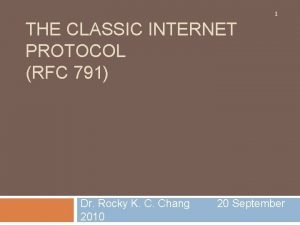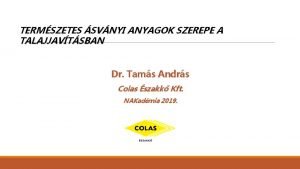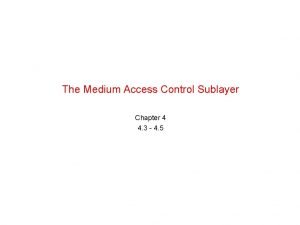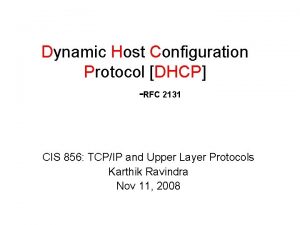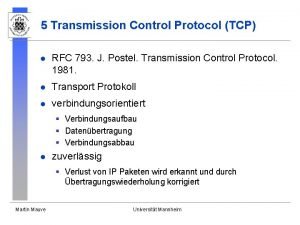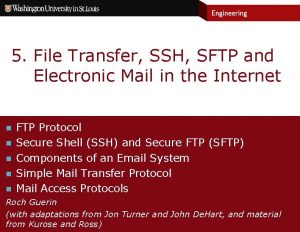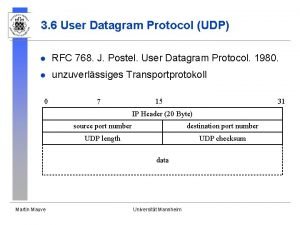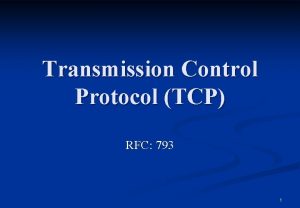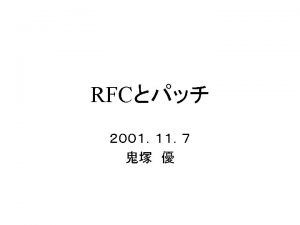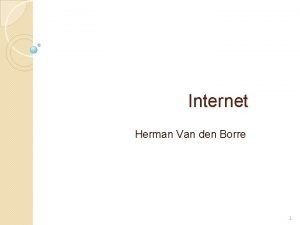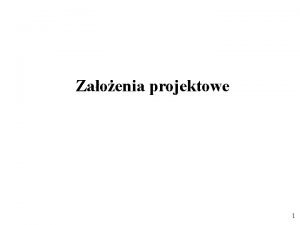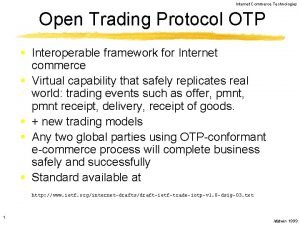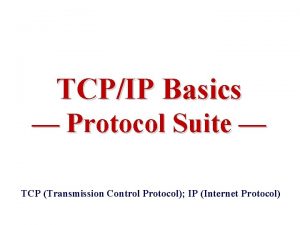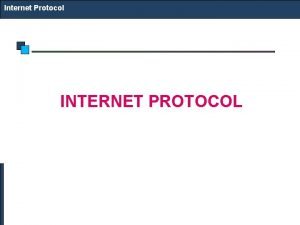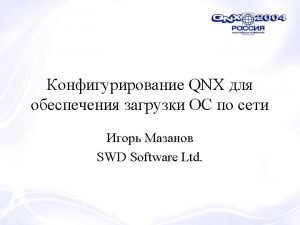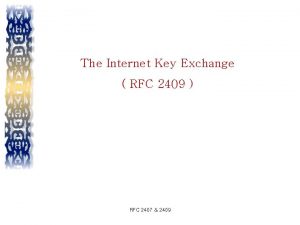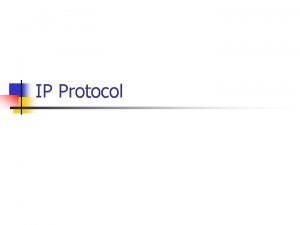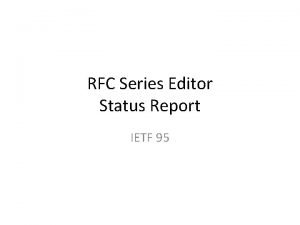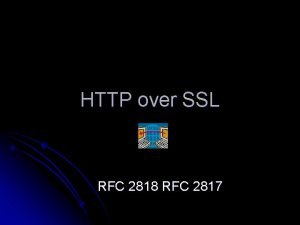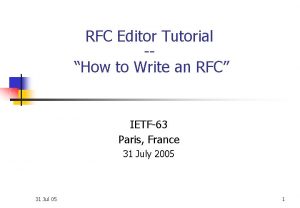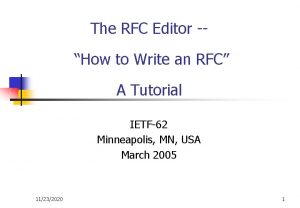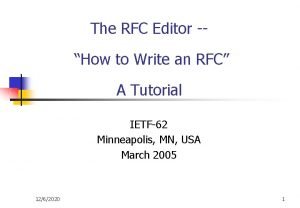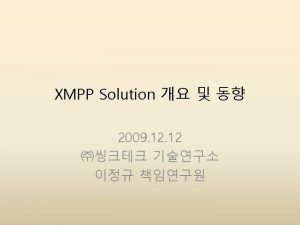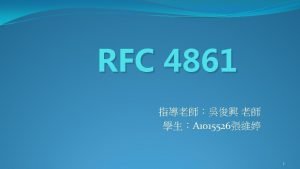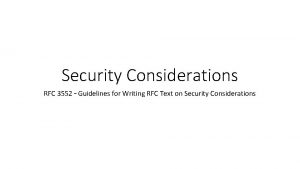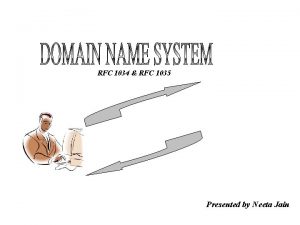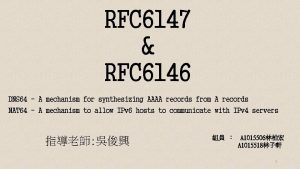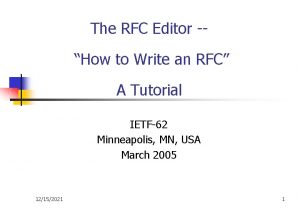1 THE CLASSIC INTERNET PROTOCOL RFC 791 Dr























- Slides: 23

1 THE CLASSIC INTERNET PROTOCOL (RFC 791) Dr. Rocky K. C. Chang 2010 20 September

2 IPv 4 header

IPv 4 datagrams 3 0 4 Version 8 HLen 16 TOS 31 Length Flags Identification Time to live (TTL) 19 Protocol Fragment offset Header checksum Source address Destination address Options (variable) Data Pad (variable)

IPv 4 header 4 Version: 4 for the current IP. Type of service (TOS) for specifying how a router should handle this datagram. Recently replaced by a 6 -bit differentiated services codepoint (RFC 2474) and a 2 -bit explicit congestion notification (RFC 3168) Header length handles a variable-length header. 20 -byte IP header without IP options

IPv 4 header 5 A 16 -bit length (count in bytes) limits the size of an IP datagram to 65, 535 bytes, including the IP header. Identification, flags, and offset are used for packet fragmentation and reassembly. Time to live (TTL) limits the number of times that a datagram processed by routers � Packets caught in routing loops � Packet scoping, especially for multicast packets. � Initial TTL value?

IPv 4 header 6 Protocol specifies the type of payload. Protocol messages on the network layer, such as ICMP (1) and IGMP (2) TCP data (6) and UDP data (17) Checksum is a 16 -bit word checksum for header’s error detection IP options: Source routing, record route, timestamp, etc, but they are rarely used today in practice.

7

Implementing IP fragmentation 8 Support unambiguous fragment reassembly. Support multiple fragmentations. Support the options of fragmentation. Cater for packet reordering. Detect fragment losses.

Fragment reassembly 9 Each fragment must share the same identity. This identity should not rely on other protocol information. The identification field is incremented after sending an IP packet. Each fragment should include its position in the original packet. Fragment offset: the offset of this fragment from the beginning of the original packet. Fragments are counted in units of 8 octets, why?

Fragment reassembly 10 As a result of using the fragment offset to indicate the fragment’s position, need to identify the last fragment. If the More-Fragment bit (the last flag) is off, this fragment is the last fragment. If any fragment does not arrive within a certain time, other received fragments in the same datagram will be discarded. Need a fragment timer.

Fragment reassembly 11 Should allow the source to have some control over IP fragmentation. A Don’t Fragment flag (the second flag) indicates whether the datagram should be fragmented.

IP fragmentation: An example 12 H 1 ETH IP (1400) R 1 R 2 FDDI IP (1400) R 3 H 8 PPP IP (512) ETH IP (512) PPP IP (376) ETH IP (376)

Start of header Ident = x (a) 0 Offset = 0 Rest of header 1400 data bytes Start of header (b) Ident = x 1 Offset = 0 Rest of header 512 data bytes Start of header Ident = x 1 Offset = 512 Rest of header 512 data bytes Start of header Ident = x 0 Offset = 1024 Rest of header 376 data bytes 13

How to reduce the IPv 4 header’s complexity? 14 More items in an IP header higher computation No options Remove the 4 -bit header length field No hop-by-hop fragmentation in the network Remove the 4 bytes of identification, flags and offset. Instead, support end-to-end fragmentation. No error detection for headers Remove the 16 -bit checksum.

IPv 6 header 15

16 ICMP

Internet control message protocol (ICMP) 17 RFCs 792 and 950 The main services provided by ICMP are: Error reporting (error) Reachability test (query) Congestion control (error) Route-change notification (error) Time stamping (query) Subnet addressing (query) Router advertisement and solicitation (query)

ICMP messages 18 ICMP messages, protected by 16 -bit checksums, are encapsulated in IP datagrams. ICMP messages are classified into error messages and query messages. Query messages include echo request and reply (Ping) router advertisement and solicitation timestamp request and reply address mask request and reply The rest are error messages

ICMP error messages 19

20

ICMP error messages 21 An ICMP error message always contains � the IP header and the first 8 bytes of the IP datagram that caused the ICMP error to be generated. An ICMP error message is never generated in response to � An ICMP error message � A datagram destined to an IP broadcast address or an IP multicast address � A datagram sent as a link-layer broadcast � A fragment other than the first

Summary 22 The IPv 4 header contains sufficient information for implementing the IP service. But there are rooms for IPv 4 to simplify the header structures. ICMP provides some useful feedbacks (queries and error reporting) for IP and the transport layer.

References 23 1. “Special-Use IPv 4 addresses, ” RFC 3330, Sept. 2002.
 Rfc 791
Rfc 791 A word 791
A word 791 Bodrogkeresztúri riolittufa
Bodrogkeresztúri riolittufa Classic ethernet mac sublayer protocol
Classic ethernet mac sublayer protocol Dhcp rfc
Dhcp rfc Tcp rfc 793
Tcp rfc 793 Rfc sftp
Rfc sftp Rfc udp
Rfc udp Bitsnn
Bitsnn Internet official protocol standards
Internet official protocol standards Adaptive internet protocol
Adaptive internet protocol Security architecture for the internet protocol
Security architecture for the internet protocol Internet protocol cursus
Internet protocol cursus Internet transport protocol in computer networks
Internet transport protocol in computer networks Voice over internet protocol
Voice over internet protocol Iotp
Iotp Protocol
Protocol Iptv internet protocol television
Iptv internet protocol television What is internet
What is internet Thế nào là hệ số cao nhất
Thế nào là hệ số cao nhất Trời xanh đây là của chúng ta thể thơ
Trời xanh đây là của chúng ta thể thơ Ng-html
Ng-html Hệ hô hấp
Hệ hô hấp Bảng số nguyên tố lớn hơn 1000
Bảng số nguyên tố lớn hơn 1000
